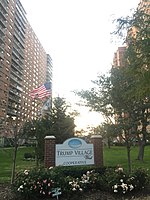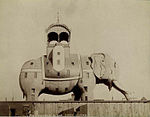Culver Depot
Coney IslandDefunct Brooklyn–Manhattan Transit Corporation stationsDefunct New York City Subway stations located abovegroundNew York City Subway stations located at-gradeRailway stations in Brooklyn ... and 2 more
Streetcar lines in BrooklynUse mdy dates from April 2020

Culver Depot, also called Culver Terminal or Culver Plaza, was a railroad and streetcar terminal in Coney Island, Brooklyn, New York City, United States, located on the northern side of Surf Avenue near West 5th Street. It was just north of the boardwalk, near the former Luna Park amusement complex, and across from the current New York Aquarium. Originally built by the Prospect Park and Coney Island Railroad for the Culver surface line, it later became a major terminal for the Brooklyn Rapid Transit Company (BRT).
Excerpt from the Wikipedia article Culver Depot (License: CC BY-SA 3.0, Authors, Images).Culver Depot
West 5th Street, New York Brooklyn
Geographical coordinates (GPS) Address Nearby Places Show on map
Geographical coordinates (GPS)
| Latitude | Longitude |
|---|---|
| N 40.575235 ° | E -73.973338 ° |
Address
Brightwater Towers East
West 5th Street 501
11224 New York, Brooklyn
New York, United States
Open on Google Maps









